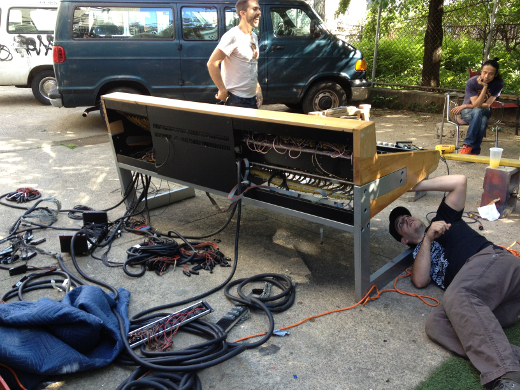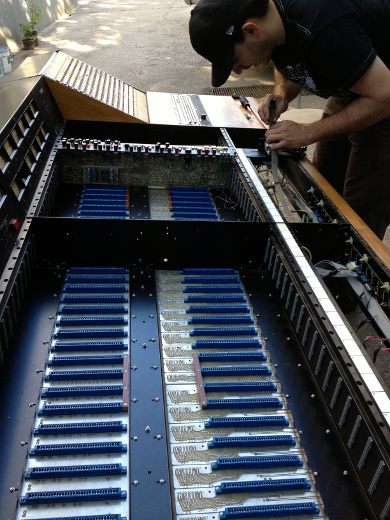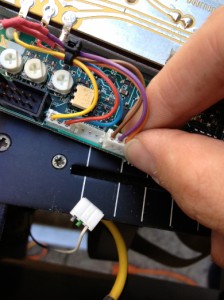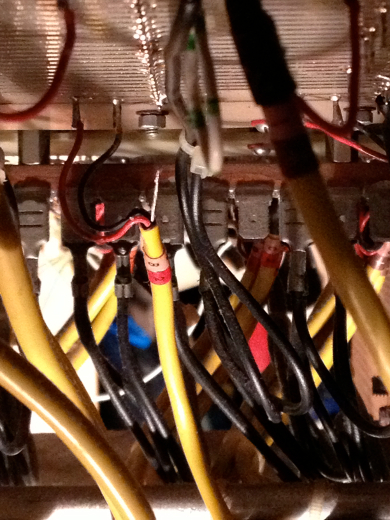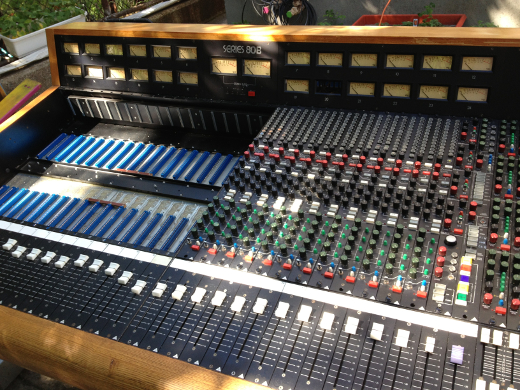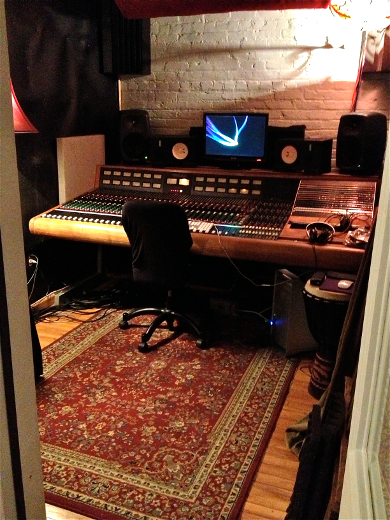Console Switch: How Brooklyn’s SpeakerSonic Installed a Trident 80b — Step by Step
He’s only in it for the gear.
We speak of SpeakerSonic’s Brian Speaker. Founder of the expanding East Williamsburg studio, we’re actually sure that Speaker loves the act of recording and hearing the music…but he obviously has an affinity for the knobs, nuts and bolts that comprise the signal path for his clients.
As SpeakerSonic grew up in its original Bushwick home, Speaker realized he was outgrowing his baby board. So what does an ambitious studio owner do when he realizes it’s time to make a serious upgrade, and move from his trusty Mackie to a Trident 80b?
Read on — you’ll get some great guidance via Speaker’s expertise, learn from his mistakes, and see how he thought on his feet on Switch Day. You’ll come away with a clear idea of how to handle your next big audio enhancement.

How did this Trident 80b make the journey into SpeakerSonic? Follow the trail… (photo credit: Charles Lavoie)
Phase One: Outgrowing a console
The first console I had was nothing fancy, that’s for sure: Mackie Onyx 1640i.
It had 16 inputs and I could plug directly into my Pro Tools rig with a simple Firewire connection, and then directly into my 16 track tape machine with the two DSUB outputs. Cheap, easy, there you go.
As I was stepping into a new role of recording more and more bands I needed more inputs, and better quality. In 2012, I was asked to produce a record that brought me over to Avatar Studios, where I got to work in Studio C. Neve VRP, 72 inputs, easy workflow, tons of outboard, super sound in the “perfect recording studio environment”. Light bulb!
You have to understand, I have been a DIY studio for years. I made music for myself and then my friends wanted me to help them make their music. I acquired gear when I had the money to afford it or found something vintage I couldn’t live without. The Mackie served its purpose as a tool to help me realize I want/need more.
The console is the heart of any good studio, and my studio was better than the console I was using. I was able to make it work for a few years, but I was getting better and better as an engineer/producer and it was a bit of surprise to people when they would hear my records, and find that I was working on such a budget console.
I hate to say it, but in a business where brands, money and vintage are the name of the game, having a budget board keeps some people away. That’s a big limitation right there.
Phase Two: Selecting the Next Desk
Being a gear junkie, I had been researching consoles for years. I needed a better long term system if I was going get to the next level in my sound.
I was familiar with the Trident consoles because for a short while I was considering the Toft series of boards. They’re “based” on the same designs as the Trident consoles, but are far cheaper. After reading some reviews about them and also getting some first-hand knowledge from several peers who’ve owned them, I decided a Toft wasn’t for me.
On the higher end, the API 1608 is a very well-liked, and upgradable board that I also considered. But being a one-man operation, I just didn’t have the budget to spend $45,000 on another 16 input console when I really needed at least 24 inputs and an HD system with some really good monitors.
Trident 80b kept creeping up into online searches, and in conversations with other producer friends as a stand out console. It’s known for its crystal clear preamps, “musical” EQs and easy workflow. And, if I could get it for a good price, right on target to my budget.
Vintage King was looking into my cause, and they had a few Tridents in varying conditions for me to consider, including one owned by Jim James of My Morning Jacket. I actually spoke with Jim about his, but it needed some work and he was at peak price for it.
All of a sudden one appeared on eBay, several thousand dollars cheaper than anywhere else, and in “excellent condition”. It was being brokered by Warren Rhoades, the original owner, from Sound Stage Studios in Nashville, TN. Warren’s reputation is impeccable and he assured me it was in excellent shape, and also came with about 10 grand worth of Mogami cable. It was on sale and at the moment, I was the only one interested.
I spoke with Warren directly about the desk. Warren was brokering it for a friend, who had owned it the last several years and needed money quick. I made an offer, stuck to my guns and shockingly I got it for a very, very good price.
Vintage King helped me put together the rest of my new system. 2 Avid 16×16 converters, a beast of a computer, and Genelec 8050b monitors. I went from DIY, to OMG overnight.
Phase Three: Planning the Install
Planning? Hmm, did I plan? Oh yeah, I measured my room, had to tear down a wall to get the console in and I had four hulks on call for arrival to do the heavy lifting. That was about the extent of my planning process. Truthfully, I had virtually no idea what I was getting myself into.
Looking back, I should have made the trip down to Nashville to decommission the console myself. Learning curves are beautiful things.
Phase Four: Load In
The console arrived at 3pm on June 4th, 2013. Wrapped in blankets and plastic with 300lbs of cable coiled on top of it.
It came fully assembled with a side of boxes containing more cable, the power supplies and the automation system. The console had to be decommissioned before it could even fit into my building.
Luckily for me it was a beautiful day so the delivery guys rolled it into the lot next to my building where I looked in awe at this massive, unbelievably beautiful vintage console. I was intimidated, excited and mostly freaking out.
It wouldn’t fit into the building with the legs still on it, this I knew. But it also would not make the assent into the building weighing almost 800lbs. I had to lighten it up and get the legs off in a hurry.
I spent the next several hours learning a lot about the console by pulling it apart, track by track. Ken Minami, of Ken South Rock, carried every piece upstairs and put them in my live room. Then he and I took out each fader, unfastening the wires, (I took a photo to remember how to put it back together), and again they made the trip to the live room. DIY indeed.
The beautiful wooden trim pieces were an easy way to lighten the load. Adam Amram, the other member of Ken South Rock, stripped off the four planks of ash and all that was left was the frame, a 300-lb umbilical of wire and the legs.
With the four hulks waiting around for the wires to come off, it was getting late. One of my helpers said I should just cut all the wire off and put it back together when it’s in the space. Ugh. I sent them all away so that I could figure out how to get the wiring off without lopping it all in one fail swoop. As the sun was going down, that was indeed an option.
l lined all the wiring out and noticed it all led back to two patch bays in the lower section of the desk. Once I pulled the bays out, and my wife and I released each patch point, the entire 300lbs of cable fell away. Sweet! The legs came off in minutes and we were in business.
The four hulks came back after a bite to eat and the desk made the assent to the third story loft. Yes, three stories, no elevator.
The Trident sat in my “live room”, which was also my living room in a big Bushwick loft, for a month while I put it back together and called in reinforcements to help me with the wiring.
Joe Salvatto of Salvatto Sound helped me with the incredible task of rewiring the console for my studio. I honestly could not have been up and running without Joe’s expert knowledge of this console and its wiring configurations. He also gave me some sweet sound damping panels and he showed me how to make wiring harnesses for the future.
Phase Five: The Hip New Sound of Today
Game Changer: The sonics were immediate.
The clarity and richness of the preamps is night and day. It’s like there’s this entire other room sitting behind the sounds now. Depth, that I had to recreate in my old set up, is right there in every recording, in every channel. The EQ’s are a nice treat as well. Lots of coloration if I want it, but now that I’ve had the console for a year, I use less and less EQ. A little goes a long way.
Before the Trident, I used EQ to help the sound, now the sound doesn’t need much help. There are still discoveries to be made with its complex and in depth patch bay. I love the onboard oscillator for calibrating my tape machine and the separate headphone mix options help immensely.
In less than a year, I had to move out of the loft because I needed more space. So the Trident again made the move, only this time to a ground floor industrial space in East Williamsburg, where it resides today.
All of my business has been through word of mouth. Once word got out about the Trident, I started getting more and more band recordings and its generated even better clients. Having 32 channels is a big change but also the onboard patch bay is so sweet. Having all of my outboard so easily accessible is a huge game changer in workflow.
I’m a better engineer today because of this console. The Trident 80b is a very user friendly and easy to understand desk.There’s less to be done in post because from input to tape, the sound is just right. It truly is the sonic heart of my operation.
— Brian Speaker

On the road again…The Movers Not Shakers crew getting the console ready for its 2nd relocation from Bushwick to it’s current home in East Williamsburg.
This article is second in a series. See the first Console Switch at The Bunker here.
Please note: When you buy products through links on this page, we may earn an affiliate commission.







